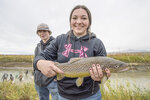Cloudy, 46° F
Volunteers from Powell and Cody high schools had barely got their boots wet when the first 2-foot-long brown trout was pulled from the Garland Canal. They got bigger through the day as the East …
This item is available in full to subscribers.
The Powell Tribune has expanded its online content. To continue reading, you will need to either log in to your subscriber account, or purchase a subscription.
If you are a current print subscriber, you can set up a free web account by clicking here.
If you already have a web account, but need to reset it, you can do so by clicking here.
If you would like to purchase a subscription click here.
Please log in to continue |
|





Volunteers from Powell and Cody high schools had barely got their boots wet when the first 2-foot-long brown trout was pulled from the Garland Canal. They got bigger through the day as the East Yellowstone chapter of Trout Unlimited, along with students from Powell and Cody high schools, headed to the Garland Canal to rescue fish caught in the canal after the faucet was closed.
While a 25-inch brown trout was the biggest of the day, there were many brown and cutthroat trout rescued most anglers would have been proud to have reeled in. In 2022, more than 100 trout between 22- to 25-inches were rescued from the canal. The record is a 29-inch monster brown.
This year’s effort isn’t over yet, but with winter blowing in, the fun factor will be diminished significantly. Trained chapter members use electrical shock with relatively high volts but low amps to immobilize fish while walking through the water and muck to catch as many of the trout as possible and move them back to the safety of nearby waterways. As many as 50,000 fish are trapped in area canals every year when irrigation needs end, said chapter member Dave Sweet.
“We can’t get them all but we do our best,” he told the students prior to getting boots wet.
The number of fish saved per year is a fraction of those trapped in the canal and depends on the weather and how many volunteers sign up to help the organization.
The inconvenience of a non-lethal electrical shock is far better than the caught trout’s fate would have been after irrigation districts close the agricultural season. The race is on when the water stops and the ditches quickly drain. The effort started about three decades ago when Powell’s Bob Capron, one of the five founding members of the chapter, couldn’t stand watching trapped fish go to waste as he and his uncle Joe Capron worked the ditch at the end of the season.
Now the annual effort, along with the push for new fish screens to keep fish out of the canals, is not only used to save buckets and buckets of trout, but to offer educational opportunities for area youth. Brooke Bessler, a Powell senior, hasn’t decided whether she’ll concentrate on wildlife or fisheries biology when she heads to Eastern Wyoming College next fall. After finishing the two-year program she’ll continue her education at the University of Wyoming.
“They have a really good wildlife and fisheries biology program down there with lots of opportunities to get hands on experience,” she said while working the bucket brigade.
She volunteered to join the trout rescue not only for community service, but to add to her list of experiences working with wildlife. She is one of several current and former students who are attracted to wildlife conservation as a career. She’s been on numerous field trips to Wyoming Game and Fish Department hatcheries and other opportunities uncommon outside of the Cowboy State. Powell High School has volunteered to assist in varied opportunities, from saving fish to helping translocate big game species.
“I think it’s the coolest thing in the world that we live in a place where we’re able to do this,” Bessler said.
The students were all enrolled in one of Powell science teacher Wendy Smith’s natural resources classes.
“This is the third or the fourth year we’ve helped with this project. It’s a lot of fun,” Smith said. “The kids get really excited to do this. It’s hard work lifting those nets and being down there all day, but they love it. They’ll always remember it.”
Chapter president Tom Brown said inviting students is important, instilling a sense of community in area youth and educating them about fisheries conservation and the impact of irrigation canals on wildlife — not to mention the help they provide the group and the chance of encouraging them to join the organization in the future.
“It gives students some hands-on experience. They can get out here and apply some of the things they’ve been learning in the classroom and I think it’s a nice way of giving back to the community a little bit,” he said.
While only a fraction of the fish trapped in the canals are saved, the chapter is persistent in reaching out to area youth.
“Trying to get them involved now is critical because they’re the future,” said project coordinator and chapter secretary Ted Richmond.
“These students are environmentally conscious. They want to do right by the environment,” he said, adding “Protecting what we have is very important to them.”
While the emphasis may have evolved into an educational opportunity, he said, it has always been about conserving native fish.
“Putting 7,000 fish back into rivers is good for everybody,” Richmond said.